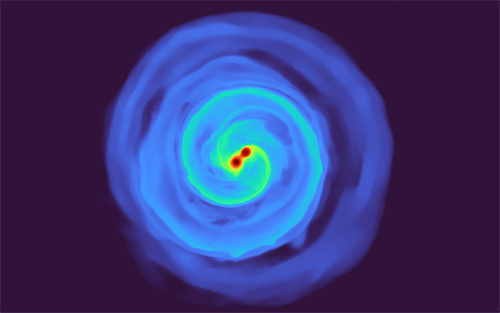| Apr 29, 2021 |
Octo-Tiger rapidly models stellar collisions
|
|
(Nanowerk News) Macquarie University astrophysicists have collaborated in the development of “Octo-Tiger,” a breakthrough astrophysics code to more efficiently model stellar collisions. The code simulates the evolution of self-gravitating and rotating systems of arbitrary geometry using adaptive mesh refinement and a new method to parallelise the code to achieve superior speeds.
|
 |
| Octo-tiger simulation of two white dwarf stars. We are looking down on the two stars as they start to merge together. The color indicates how dense the gas is in the orbital or midplane, with brown indicating the densest gas and blue the least dense. The arrows indicate the speed of the gas. Red arrows correspond to high velocities of 1,000 km/s and blue arrows correspond to low velocities of 1 km/s. Time is shown in seconds in the upper-left corner. The binary initially completes an orbit every two minutes and the total simulated time is less than two hours, representing the last hours in the life of this binary before merging. (Image: Macquarie University)
|
|
Professor Orsola De Marco from Macquarie University's Department of Physics and Astronomy was part of a unique collaboration between experimental computer scientists and astrophysicists in the LSU Department of Physics & Astronomy, the LSU Center for Computation & Technology, Indiana University Kokomo, and Macquarie University, culminating in over of a year of benchmark testing and scientific simulations, supported by multiple NSF grants, including one specifically designed to break the barrier between computer science and astrophysics.
|
|
“Thanks to a significant effort across this collaboration, we now have a reliable computational framework to simulate stellar mergers,” says Patrick Motl, professor of physics at Indiana University Kokomo. “By substantially reducing the computational time to complete a simulation, we can begin to ask new questions that could not be addressed when a single-merger simulation was precious and very time consuming. We can explore more parameter space, examine a simulation at very high spatial resolution or for longer times after a merger, and we can extend the simulations to include more complete physical models by incorporating radiative transfer, for example.”
|
|
Recently published in Monthly Notices of the Royal Astronomical Society ("Octo-Tiger: A New, 3D Hydrodynamic Code for Stellar Mergers That Uses HPX Parallelisation,"), the paper investigates the code performance and precision through benchmark testing.
|
|
The authors, Dr. Dominic C. Marcello, postdoctoral researcher; Dr. Sagiv Shiber, postdoctoral researcher; Dr. Juhan Frank, professor; Dr. Geoffrey C. Clayton, professor; Dr. Patrick Diehl, research scientist; and Dr. Hartmut Kaiser, research scientist, of Louisiana State University—together with collaborators Dr. Orsola De Marco, professor at Macquarie University and Dr. Patrick M. Motl, professor at Indiana University Kokomo—compared their results to analytic solutions, when known, and other grid-based codes, such as the popular FLASH.
|
|
In addition, they computed the interaction between two white dwarfs from the early mass transfer through to the merger and compared the results with past simulations of similar systems.
|
|
“A test on Australia’s fastest supercomputer, Gadi (#25 in the World’s Top 500 list), showed that Octo-Tiger, running on a core count over 80,000, displays excellent performance for large models of merging stars,” Professor De Marco said. “With Octo-Tiger, we cannot only reduce the wait time dramatically, but our models can answer many more of the questions we care to ask.”
|
|
Octo-Tiger is currently optimized to simulate the merger of well-resolved stars that can be approximated by barotropic structures, such as white dwarfs or main sequence stars. The gravity solver conserves angular momentum to machine precision, thanks to a correction algorithm. This code uses HPX parallelization, allowing the overlap of work and communication and leading to excellent scaling properties to solve large problems in shorter time frames.
|
|
“This paper demonstrates how an asynchronous task-based runtime system can be used as a practical alternative to Message Passing Interface to support an important astrophysical problem,” Diehl said.
|
|
The research outlines the current and planned areas of development aimed at tackling a number of physical phenomena connected to observations of transients.
|
|
“While our particular research interest is in stellar mergers and their aftermath, there are a variety of problems in computational astrophysics that Octo-Tiger can address with its basic infrastructure for self-gravitating fluids,” Motl said.
|

